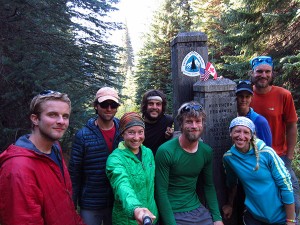
By Steve Ritchie
Most people would take a photograph of the achievement or call a friend to share the news.
Cousins Dorothy Brown-Kwaiser and Melissa Kwaiser-DeKalita did a handstand or a headstand to celebrate reaching milestones along the Pacific Crest Trail such as a state border, a 1,000 mile mark or a natural landmark like Crater Lake.
And there they did one when they finished the trail – 2,669 miles. 150 days of hiking 20 miles a day with a 30 lb. pack. The experience: Priceless.
Dorothy Brown-Kwaiser, interpretive park ranger at Silver Falls State Park and Silverton resident since 2006, left town in April and returned in October after hiking the Pacific Crest Trail from Mexico to Canada over a five-month period with her cousin, Melissa Kwaiser-DeKalita of Michigan.
Brown-Kwaiser, 34, is a mountain climber and has run numerous marathons. She said she has always been interested in “big adventures.”
Dorothy Brown-Kwaiser talks about
hiking the Pacific Crest Trail.
The public is invited.Thursday, Dec. 13, 7:30 pm
Creekside Grill, 242 S. Water St.
Read about her trip at:
dorothyspctblog.blogspot.com
During college, she took a year off from school to do a 77-day Outward Bound course that gave her outdoor skills and the desire for wilderness adventures.
The practicalities of life intervened for awhile, but Brown-Kwaiser decided two years ago that it was time to put up or shut up.
“Moving out here (to Oregon) from the Midwest is what me made decide to do the PCT,” Brown-Kwaiser said. “In the summer of 2010 I got sick of hearing myself talk about it and just decided I was going to do it in 2012. I started my savings account and that made it official that I was going to be hiking. I started putting $400 a month in my savings account – I calculated it would take about $8,000 for the gear, for insurance while I was on leave (from work), and my other expenses.“

Brown-Kwaiser said Park Manager Kevin Strandberg and her immediate supervisor Carl Shepherd were very supportive of her request for a six-month unpaid leave.
“I had support from all levels at OPRD (Oregon Parks and Recreation Dept.). Carl was really excited about it. While I was on the trail he was probably more excited about it than anybody,” Brown-Kwaiser said with a laugh. “I would call him (from the trail) once in awhile and he was just ecstatic talking about it.“
Shepherd said he was “100 percent in support” of the plan, though he noted, “She might be only 5-feet tall but she has size 14 shoes to fill here at the park.”
Shepherd said he thought Brown-Kwaiser was the “most natural teacher in an outdoor setting I’ve ever seen,“ and both Strandberg and Shepherd said her PCT hike would ultimately benefit the park.
To prepare for her trip, Brown-Kwaiser spent months reading about the PCT, and more months deciding how to re-supply along the way.
“People go at it different ways. I’m a planner, so I had my spreadsheets and logistical tools all laid out. I bought all my food ahead of time and sent the packages out so I knew what was coming. I shipped 25 packages of food to various points on the trail. On average I picked up a package every five days, but once we went 11 days in the Sierra Nevadas without replenishing.”
She also laid out an ambitious training plan to get in shape for the hike, but didn’t really follow it, preferring to continue lifting weights, and running twice a week – her usual routine. She also started doing a weekly hike and worked up to 15 miles.
Dorothy also started going to jazzercise class twice a week, something she had done with her mom as a grade schooler. She not only enjoyed doing jazzercise again, but found that it improved her strength, coordination and “nimbleness!”
Part of the gear purchased for the hike was her first cell phone.
“I never wanted a cell phone before, but I knew I wanted to blog, so I needed one. I’m still a little embarrassed by it, but I haven’t given it up yet.”
Brown-Kwaiser’s blog (dorothyspctblog.blogspot.com) makes for some fascinating reading. Many people followed her blog closely, including her co-workers and many of the students at Silver Crest Elementary School.
After planning the trek as a solo hike, Brown-Kwaiser was joined by her cousin, who decided at the last minute to go. Brown-Kwaiser said that a total of 800 “through hiking” permits were issued for PCT hikers in 2012, but she thought that only about 300 actually completed its entire length.
The days on the trail were long and grueling. Brown-Kwaiser’s alarm went off at 5 a.m. and her typical day looked something like this:
5:30 a.m. Pack while eating a couple protein bars;
6 a.m., Hit the trail;
9 a.m. Second breakfast; noon, lunch of cheese and crackers, jerky and dried fruit; 1 p.m. Back on the trail;
4 p.m. break, snack or dinner;
8 p.m. Make camp, dinner, blog, sleep.
Brown-Kwaiser stayed healthy and lost only 10-12 pounds on the journey. Dinner was either ground turkey and rice, mashed potatoes, burritos, ramen or spaghetti.
“At one point every day there was a Snickers bar. At least one, sometimes two.
“I had enough food. I calculated it out – 3,500 – 4,000 calories a day and it was too much. I couldn’t finish the dinners . . . We would eat whenever it was convenient. If there was water on the trail in the afternoon we might cook dinner then so we didn’t have to carry the water. One liter of water was an extra 2.2 pounds of weight in the pack.”

With the threat of snow and cold in the North Cascades, PCT hikers need to finish by the end of September.
Brown-Kwaiser and her cousin had 150 days to finish the trip, and needed to average 20 miles a day on the trail. That was without figuring in “zeroes” and “neros” – trail lingo for days when, they did not hike and days when mileage was limited.
But the challenge was not just a physical one, Brown-Kwaiser said.
“The mental part is harder than you think. We hiked for about 12-14 hours a day and what do you think about that whole time, all day long. I love planning so I planned things for work, planned things for when I got home. . . You have to keep your head busy with different things. I had my MP3 player and listened to books and that was nice . . . . You have to be careful not to get a song stuck in your head – that can make you crazy.
“We didn’t get much news . . . What was really nice was going to town. That’s where you got your care packages, Internet service, letters from home . . . It’s always a morale boost when you do that.”
The worst trail section for Brown-Kwaiser was through Northern California. The hilly terrain in the Sierras, 100+ degree heat, a developing case of plantar fasciitis, and a worrying encounter with a stalker on the trail made that part of the trip a struggle. Once the pair made it to the Oregon border, her outlook brightened.
“I was so excited to hit the (Oregon) border,” Brown-Kwaiser said. “I felt like I was home… Crater Lake, Mt. Thielsen, the Three Sisters. To hit Three-Fingered Jack and walk straight to Mt. Jefferson in the same day was really neat . . . We just flew – 25 miles a day – Oregon is relatively flat and there’s a lot of great places to stop – campgrounds and parks that are close to the trail . . . and there were friends who caught up with us. It was morale booster.”
The last month of the trip was in Washington and Brown-Kwaiser wasn’t sure what to expect there.
“The first couple of days coming out of the Gorge weren’t that great . . but then on day 4 or 5 we hit Goat Rocks and it was beautiful. We had our most magical morning ever there. It had stormed the night before, but the dawn was clear. We could see Mt. Rainier and all over and it was just beautiful.
The arrival of stormy fall weather made finishing on schedule crucial, and the pair made it to the Canadian border on Sept. 27, their planned finish date. Greeted by friends and family, it was a joyous occasion, but Brown-Kwaiser wasn’t prepared for what came next.
After being on the trail for months and having such an intense experience of day-to-day survival, Brown-Kwaiser found the transition back to “normal life” to be challenging. She had friends who compared it to different kinds of culture shock they had experienced, like returning from a volunteer stint in a Third World country, returning from a war zone, or even pregnancy and birth. Even her trail name – “Bacon Bit” – seemed more who she was than “Dorothy.” She was glad to have two weeks before she returned to work.
“Those two weeks were hard – I think I cried every day about something,” she said. “Not that I was crying all day or anything, but something would trigger it. Little things would just trigger that emotion . . . It’s a big event that changes you and changes your life.
Asked how it might have changed her, Brown-Kwaiser said, “I feel more at ease, more like myself. I’m a busy-body, so I wanted to learn to relax more and I think the trip did that for me. It helps you to sort out your priorities. And, it’s official, I’m now less afraid of the dark!”
